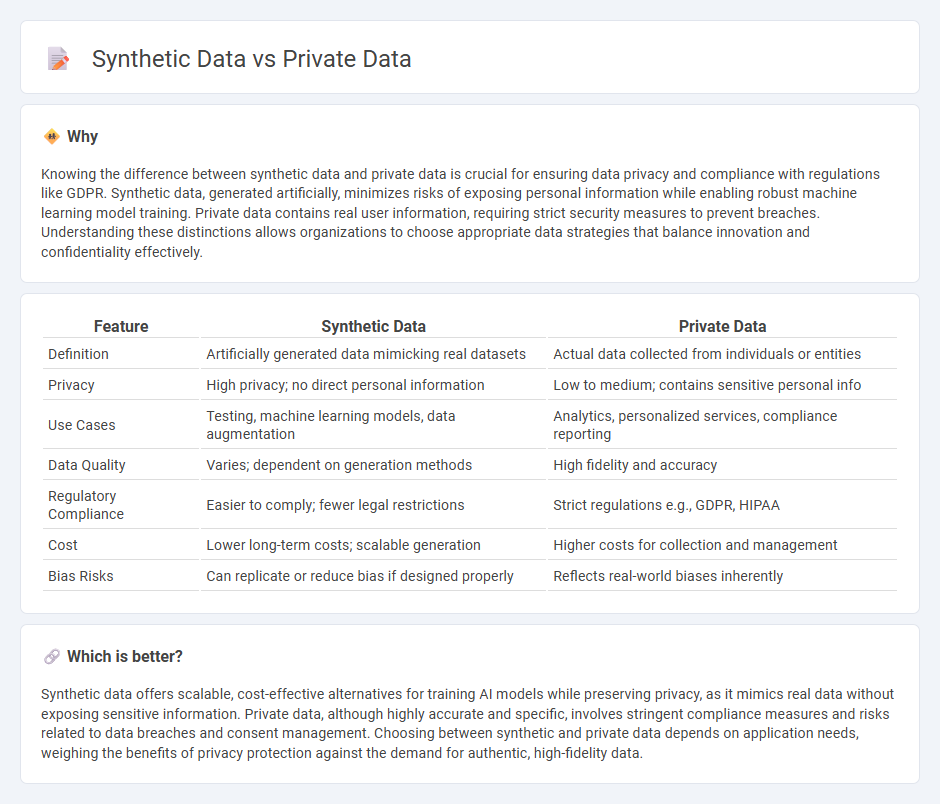
Synthetic data is artificially generated information designed to mimic real-world data patterns without revealing sensitive personal details, enhancing data privacy and security. Private data, consisting of actual user information, requires stringent protection to prevent unauthorized access and maintain confidentiality. Explore the benefits and challenges of synthetic versus private data to understand their roles in modern technology.
Why it is important
Knowing the difference between synthetic data and private data is crucial for ensuring data privacy and compliance with regulations like GDPR. Synthetic data, generated artificially, minimizes risks of exposing personal information while enabling robust machine learning model training. Private data contains real user information, requiring strict security measures to prevent breaches. Understanding these distinctions allows organizations to choose appropriate data strategies that balance innovation and confidentiality effectively.
Comparison Table
| Feature | Synthetic Data | Private Data |
|---|---|---|
| Definition | Artificially generated data mimicking real datasets | Actual data collected from individuals or entities |
| Privacy | High privacy; no direct personal information | Low to medium; contains sensitive personal info |
| Use Cases | Testing, machine learning models, data augmentation | Analytics, personalized services, compliance reporting |
| Data Quality | Varies; dependent on generation methods | High fidelity and accuracy |
| Regulatory Compliance | Easier to comply; fewer legal restrictions | Strict regulations e.g., GDPR, HIPAA |
| Cost | Lower long-term costs; scalable generation | Higher costs for collection and management |
| Bias Risks | Can replicate or reduce bias if designed properly | Reflects real-world biases inherently |
Which is better?
Synthetic data offers scalable, cost-effective alternatives for training AI models while preserving privacy, as it mimics real data without exposing sensitive information. Private data, although highly accurate and specific, involves stringent compliance measures and risks related to data breaches and consent management. Choosing between synthetic and private data depends on application needs, weighing the benefits of privacy protection against the demand for authentic, high-fidelity data.
Connection
Synthetic data is generated using algorithms to mimic real private data without exposing sensitive information, enhancing data privacy and security. It serves as a valuable tool for training machine learning models while avoiding compliance risks associated with directly using private datasets. This connection enables organizations to innovate in technology-driven fields like AI and analytics without compromising user confidentiality.
Key Terms
Privacy
Private data contains sensitive information collected directly from individuals, posing significant privacy risks due to potential unauthorized access, breaches, or misuse. Synthetic data mimics real datasets using algorithms, offering strong privacy protection by eliminating direct identifiers and reducing the risk of re-identification while maintaining analytical value. Explore how synthetic data transforms privacy protection and supports compliance with data regulations in modern analytics.
Anonymization
Private data requires rigorous anonymization techniques such as data masking, pseudonymization, and differential privacy to protect individual identities and comply with regulations like GDPR and CCPA. Synthetic data, generated through AI models, inherently reduces privacy risks by creating artificial datasets that mimic real data without exposing personal information. Explore the advantages and methodologies of anonymization in synthetic data to enhance data privacy and utility.
Data Generation
Private data ensures authenticity by using real-world information but often faces limitations in availability and privacy concerns. Synthetic data offers scalable, privacy-preserving alternatives generated through algorithms like GANs or variational autoencoders, enabling broader use in data-hungry applications. Explore the dynamics of data generation to better understand the advantages and challenges of both approaches.
Source and External Links
9 Examples of Private Data - Private data is information related to a person that can reasonably be expected to be secured from public view, such as names, contact details, medical, financial, and communications data.
Personal data - Personal data, as defined by regulations like the GDPR, includes any information relating to an identified or identifiable individual, such as IP addresses, and may be protected globally under various privacy laws.
What is data privacy? - Data privacy is the right and ability of individuals to control how their personal information is collected, used, and shared, especially in the context of internet and digital services.
 dowidth.com
dowidth.com